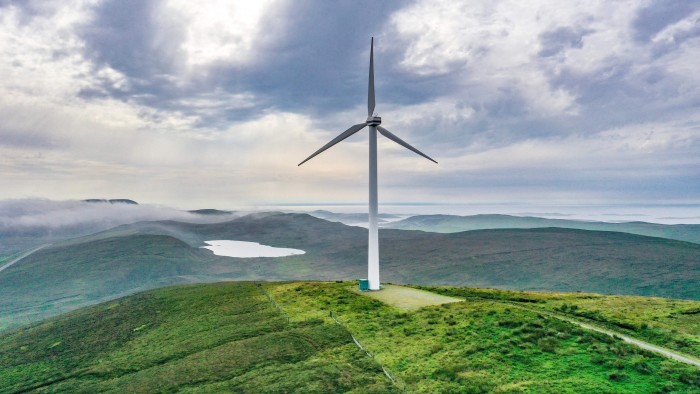Everyone likes a bargain. Investors could consider a whole sector right now: renewable energy infrastructure funds — if, that is, they are prepared to accept the risks.
Renewable energy infrastructure funds traditionally own solar or wind farms, though in recent years some have diversified their assets into other areas including hydrogen and battery storage. This gives them a steady stream of revenue that is often linked to inflation, meaning that the trusts have traditionally been attractive to investors looking for a regular income.
However, the past three years have not been kind to the sector. Higher interest rates have made government bond yields look like a more attractive source of income, leading to an investor exodus from the trusts.
The result is that renewable energy infrastructure funds are trading at an average discount of 32 per cent.
To some, that might look like a bargain. The longer-term outlook for renewable energy has been given a boost by the Labour government, which has set a clean power target for 2030, up from the previous target of 2035. In theory, that means the net asset value of many of the trusts should rise over the longer term, though analysts are sceptical the government’s plans to encourage more private investment into the sector will succeed.
A more concrete positive for the sector is falling interest rates. That should make infrastructure assets look attractive again relative to government bonds, analysts believe, given their yields of 6-8 per cent compared with 4-4.5 per cent on gilts. Other bright spots include a recent uptick in power prices, and the ongoing case for growth in the renewable energy sector in the years ahead.
As a result, analysts believe that the sell-off in the sector as a whole has been indiscriminate, and that there are bargains to be found.
“There are a number of positives out there. Some of the valuations are quite attractive,” says Iain Scouller, an analyst at Stifel.
He recommends Greencoat UK Wind, citing its good dividend cover and an inflation-linked dividend, Bluefield Solar Income with a decent dividend yield of around 8 per cent and Octopus Renewables with its diversified portfolio in Europe and Australia as well as the UK.
Elliott Hardy, an analyst at Winterflood, predicts that as interest rates fall, discounts will come down as retail investors switch back to investment trusts.
So far, lower interest rates have not have much of an effect on investor behaviour. Victoria Hasler, head of fund research at Hargreaves Lansdown, says while there has been a bit of a pick-up in interest in renewable energy infrastructure trusts, “a lot of investors are still happy to sit in cash and wait to see what happens next”.
Hardy also says it is important to look at what positive steps boards have taken to try and improve things. Share buybacks are one sign that a board is doing its best. “We tend to take the view that even if it doesn’t move the dial with the discount, it’s a signal of good intent,” he notes.
Some trusts are trading on heavy discounts for good reasons. Many have huge levels of borrowing, also known as gearing. NextEnergy Solar Fund, for example, has debt as a percentage of its net asset value of 93 per cent and is trading on a discount of 29 per cent.
32%Average discount traded by renewable energy infrastructure funds
Other trusts have had specific issues — the Renewables Infrastructure Group has had cable outages at its UK offshore wind farms. Foresight Environmental Infrastructure and HydrogenOne Capital Growth were recently hurt after one of their hydrogen companies, HH2E, went bust. For Hardy at Winterflood, though, this represented a buying opportunity, arguing that the sell-off in Foresight’s share price was overdone.
And the sector as a whole still faces challenges. It has been a bad year for power prices, with the UK seeing lower wind speeds and less sun than usual in the first half of the year, Scouller points out. That has affected power generation, and helped average net asset values in the sector to fall between 3 and 5 per cent this year. With power prices being notoriously volatile in recent years, there is no guarantee of an uptick next year.
Matt Hose, an analyst at Jefferies, warns that some trusts could even be forced to close. Many are stuck with assets that they need to sell to pay debt, and have been unable to raise new capital due to their heavy discounts.
The next year will see a new wave of so-called discontinuation votes, whereby trusts have to offer shareholders a vote on winding down the fund if the discount is wider than 10 per cent. In the past year, shareholders gave them a pass, but “this time, shareholders will be less forgiving,” Hose says.
He predicts a period of “creative destruction” where some funds will die — particularly the smaller ones — while other larger funds will survive and narrow their discounts.
All in all, investors have a lot of hurdles to look past in the renewable energy infrastructure sector to feel they are really getting a bargain. Much will depend in the coming year on energy prices as well as board behaviour.
“Going into next year, a lot depends on what happens with power prices,” says Scouller. “It’s been quite a tough 2024.”
The author holds a fund of funds, which includes Greencoat UK Wind, the Renewables Infrastructure Group and Octopus Renewables, at a total weighting of 1.4 per cent.
Read the full article here

